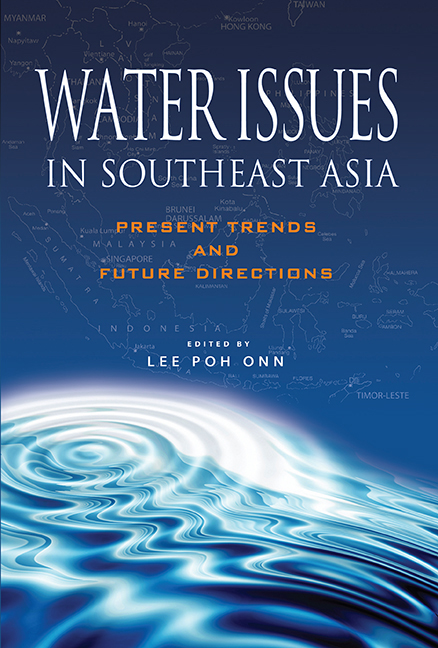Book contents
- Frontmatter
- Contents
- List of Tables, Figures, Boxes and Photos
- Acknowledgements
- About the Contributors
- CHAPTER 1 Introduction
- CHAPTER 2 China and the Potential for Conflict over Water among Eurasian States
- CHAPTER 3 River Basin Agreements as Facilitators of Development
- CHAPTER 4 Privatization of Water Services via Public-Private Partnership and Implications for Southeast Asia
- CHAPTER 5 Indonesia's Water Management Reform
- CHAPTER 6 Water Resource Management Issues in Malaysia
- CHAPTER 7 Privatization Issues in Water Supply in Malaysia
- CHAPTER 8 Troubled Waters: Rehabilitating the Pasig River, the Philippines
- CHAPTER 9 The Privatization of Water Services in Metro Manila: Lessons from a Mixed Outcome
- CHAPTER 10 Singapore's Experience in Water Resource Management
- CHAPTER 11 Thailand's Water Sector: Overview and Implications
- CHAPTER 12 Water Resources and Issues Concerning Sustainable Watershed Management Practices in Vietnam
- Index
CHAPTER 2 - China and the Potential for Conflict over Water among Eurasian States
Published online by Cambridge University Press: 21 October 2015
- Frontmatter
- Contents
- List of Tables, Figures, Boxes and Photos
- Acknowledgements
- About the Contributors
- CHAPTER 1 Introduction
- CHAPTER 2 China and the Potential for Conflict over Water among Eurasian States
- CHAPTER 3 River Basin Agreements as Facilitators of Development
- CHAPTER 4 Privatization of Water Services via Public-Private Partnership and Implications for Southeast Asia
- CHAPTER 5 Indonesia's Water Management Reform
- CHAPTER 6 Water Resource Management Issues in Malaysia
- CHAPTER 7 Privatization Issues in Water Supply in Malaysia
- CHAPTER 8 Troubled Waters: Rehabilitating the Pasig River, the Philippines
- CHAPTER 9 The Privatization of Water Services in Metro Manila: Lessons from a Mixed Outcome
- CHAPTER 10 Singapore's Experience in Water Resource Management
- CHAPTER 11 Thailand's Water Sector: Overview and Implications
- CHAPTER 12 Water Resources and Issues Concerning Sustainable Watershed Management Practices in Vietnam
- Index
Summary
Managing freshwater in rivers that cross borders or form boundaries between nations is a global issue with particular relevance for Asia. It places China in the focus of a new spotlight — one that will bring the world's most populous nation under the increasingly critical scrutiny of its water-dependent neighbours in Southeast Asia, South Asia, Central Asia and Russia. China itself has a growing thirst for water. It has 20 per cent of the planet's population but only 7 per cent of its total freshwater resources. Yet China is Eurasia's dominant headwater power. Most of its great rivers and many of those that enable nearby nations to flourish start from the snow-fed highlands on the “roof of the world”, the Qinghai-Tibetan Plateau, which is centred in western China. Chinese control over the critical upstream sections of these transborder rivers is a factor that must be added to the country's rise as an economic, political, military and cultural force in regional affairs. It is an aspect of growing Chinese influence on nearby states that is seldom recognized and therefore underestimated.
Geography has dictated that many of the big rivers sustaining people, agriculture and industry in Southeast Asia, South Asia, Central Asia and Russia east of the Ural Mountains start in Chinese territory. Southeast Asia's largest rivers come from deep inside China. Among them are the Salween, Mekong and Red rivers. Other transboundary rivers that emerge from China include the Songhua, Ili and Irtysh rivers flowing into Russia and/or Kazakhstan. Long stretches of the headwaters of the Brahmaputra River pass through China before they reach India's Ganges River and Bangladesh. What China does to this vital supply of freshwater (by building dams, diverting flows for its own use or polluting the upstream sections of the rivers) affects its downstream neighbours. This was graphically illustrated in late 2005 when a toxic chemical spill into China's Songhua River was carried into Russia's adjoining Amur River, drawing Russian protests and raising fears about long-term pollution of a vital drinking and fishing source.
- Type
- Chapter
- Information
- Water Issues in Southeast AsiaPresent Trends and Future Direction, pp. 27 - 55Publisher: ISEAS–Yusof Ishak InstitutePrint publication year: 2012

